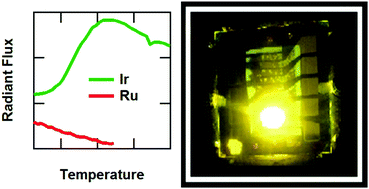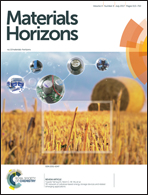Understanding the superior temperature stability of iridium light-emitting electrochemical cells†
Abstract
Single-layer light-emitting electrochemical cells from ionic transition metal complexes (iTMCs) are relatively simple to construct and have great potential as cost effective emissive devices. Most studies to date have focused on iTMC devices from ruthenium and iridium chromophores. For practical applications, thermal stability is important for environmental robustness, and little has been said about their relative thermal stability. Here, we studied the device performance of iridium and ruthenium iTMCs with temperature to directly compare their stabilities. The thermal onset of radiant flux loss is found to be 67 °C (152 °F) for iridium devices, 45 °C higher than ruthenium iTMCs, a show of their superior thermal stability. We subsequently used temperature-dependent electrochemical impedance spectroscopy, temperature-dependent photoluminescence spectroscopy, time resolved photoluminescence spectroscopy, and photoluminescence quantum yield measurements to understand the physical origin of this substantial temperature stability difference. Prior postulates suggested that films from iridium complexes would yield better thermal stability than those from ruthenium complexes due to details of the orbital energetics. Instead, it is found that this superiority is owed to the details of kinetic effects—the competing kinetics of multiple recombination pathways and the relative rates of radiative to nonradiative processes. Such information guides the design of iTMC emitters for superior light-emitting electrochemical cells.



 Please wait while we load your content...
Please wait while we load your content...